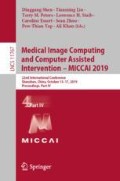Abstract
Prediction of Alzheimer’s disease before the onset of symptoms is an important clinical challenge, as it offers the potential for earlier intervention to interrupt disease progression before the development of dementia symptoms, as well as spur new prevention and treatment avenues. In this work, we propose a model that learns how to predict Alzheimer’s disease ahead of time from structural Magnetic Resonance Imaging (sMRI) data. The contributions of this work are two-fold: (i) We use the latent variables learned by our model to visualize areas of the brain, which contribute to confident decisions. Our model appears to be focusing on specific areas of the neocortex, cerebellum, and brainstem, which are known to be clinically relevant. (ii) There are various ways in which disease might evolve from a patient’s current physiological state. We can leverage the latent variables in our model to capture the uncertainty over possible future patient outcomes. It can help identify and closely monitor people who are at a higher risk of disease, despite the current lack of clinical indications.
Access this chapter
Tax calculation will be finalised at checkout
Purchases are for personal use only
Notes
- 1.
Each MRI is associated with the label of the next MRI of the same patient.
- 2.
All the MRIs corresponding to a patient in the training set lie in the training set only.
References
Adaszewski, S., et al.: How early can we predict Alzheimer’s disease using computational anatomy? Neurobiol. Aging 34(12), 2815–2826 (2013)
Alexiou, A., et al.: A Bayesian model for the prediction and early diagnosis of Alzheimer’s disease. Front. Aging Neurosci. 9, 77 (2017)
Braak, H., Braak, E.: Staging of Alzheimer’s disease-related neurofibrillary changes. Neurobiol. Aging 16(3), 271–278 (1995)
Collins, D.L., et al.: Automatic 3D intersubject registration of mr volumetric data in standardized talairach space. J. Comput. Assist. Tomogr. 18(2), 192–205 (1994)
Coupé, P., et al.: An optimized blockwise nonlocal means denoising filter for 3-D magnetic resonance images. IEEE Trans. Med. Imaging 27(4), 425–441 (2008)
Denton, E., Fergus, R.: Stochastic video generation with a learned prior. In: ICML, vol. 80, pp. 1174–1183 (2018)
Dickerson, B.C., et al.: The cortical signature of Alzheimer’s disease: regionally specific cortical thinning relates to symptom severity in very mild to mild AD dementia and is detectable in asymptomatic Amyloid-Positive individuals. Cereb. Cortex 19(3), 497–510 (2009)
Folstein, M.F., et al.: Mini-mental state. A practical method for grading the cognitive state of patients for the clinician. J. Psychiatric Res. 12(3), 189–98 (1975)
Fonov, V., et al.: Unbiased average age-appropriate atlases for pediatric studies. Neuroimage 54(1), 313–327 (2011)
Friedman, J., et al.: Sparse inverse covariance estimation with the graphical lasso. Biostatistics 9, 432–441 (2007)
Gupta, A., et al.: Natural image bases to represent neuroimaging data. In: ICML, pp. III-987–III-994 (2013)
Hosseini-Asl, E., et al.: Alzheimer’s disease diagnostics by a deeply supervised adaptable 3D convolutional network. Front. Biosci. (Landmark Ed) 23, 584–596 (2018)
Jack Jr., C.R., et al.: NIA-AA research framework: toward a biological definition of Alzheimer’s disease. Alzheimers. Dement. 14(4), 535–562 (2018)
Kingma, D.P., Welling, M.: Auto-encoding variational bayes. In: ICLR (2013)
Kohl, S.A.A., et al.: A probabilistic u-net for segmentation of ambiguous images. In: NeurIPS, June 2018
Lee, G., et al.: Predicting Alzheimer’s disease progression using multi-modal deep learning approach. Sci. Rep. 9, 1952 (2019)
Liu, S., et al.: Early diagnosis of Alzheimer’s disease with deep learning. In: ISBI, pp. 1015–1018 (2014)
van der Maaten, L., Hinton, G.: Visualizing data using t-SNE. J. Mach. Learn. Res. 9, 2579–2605 (2008)
Mueller, S.G., et al.: Alzheimer’s disease neuroimaging initiative. Neuroimaging Clin. North Am. 15(4), 869–877 (2005)
Ortiz, A., et al.: Exploratory graphical models of functional and structural connectivity patterns for Alzheimer’s disease diagnosis. Front. Comput. Neurosci. 9, 132 (2015)
Payan, A., Montana, G.: Predicting Alzheimer’s disease: a neuroimaging study with 3D convolutional neural networks. In: ICPRAM, vol. 2 (2015)
Perl, D.P.: Neuropathology of Alzheimer’s disease. Mt Sinai J. Med. 77(1), 32–42 (2010)
Simic, G., et al.: Does Alzheimer’s disease begin in the brainstem? Neuropathol. Appl. Neurobiol. 35(6), 532–554 (2009)
Sled, J.G., et al.: A nonparametric method for automatic correction of intensity nonuniformity in MRI data. IEEE Trans. Med. Imaging 17(1), 87–97 (1998)
Suk, H.-I., Shen, D.: Deep learning-based feature representation for AD/MCI classification. In: Mori, K., Sakuma, I., Sato, Y., Barillot, C., Navab, N. (eds.) MICCAI 2013. LNCS, vol. 8150, pp. 583–590. Springer, Heidelberg (2013). https://doi.org/10.1007/978-3-642-40763-5_72
Wegiel, J., et al.: Cerebellar atrophy in Alzheimer’s disease-clinicopathological correlations. Brain Res. 818(1), 41–50 (1999)
Wolz, R., et al.: Multi-method analysis of MRI images in early diagnostics of Alzheimer’s disease. PLoS ONE 6(10), e25446 (2011)
Zhou, B., et al.: Learning deep features for discriminative localization. In: CVPR, pp. 2921–2929, June 2016
Acknowledgement
This work was generously funded by Healthy Brains for Healthy Lives (HBHL) through CFREF grant. We would also like to thank Koustuv Sinha for useful discussions, comments and reviews of the manuscript.
Author information
Authors and Affiliations
Corresponding author
Editor information
Editors and Affiliations
Rights and permissions
Copyright information
© 2019 Springer Nature Switzerland AG
About this paper
Cite this paper
Basu, S., Wagstyl, K., Zandifar, A., Collins, L., Romero, A., Precup, D. (2019). Early Prediction of Alzheimer’s Disease Progression Using Variational Autoencoders. In: Shen, D., et al. Medical Image Computing and Computer Assisted Intervention – MICCAI 2019. MICCAI 2019. Lecture Notes in Computer Science(), vol 11767. Springer, Cham. https://doi.org/10.1007/978-3-030-32251-9_23
Download citation
DOI: https://doi.org/10.1007/978-3-030-32251-9_23
Published:
Publisher Name: Springer, Cham
Print ISBN: 978-3-030-32250-2
Online ISBN: 978-3-030-32251-9
eBook Packages: Computer ScienceComputer Science (R0)


